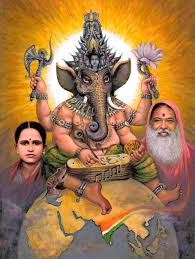The asthanga bhakti yoga sutras
Who takes on the responsibility of those devotees who have surrendered totally? What happens when the devotee does not seek anything? In such a case, Swamiji’s responsibility towards the devotee would have increased. He thinks of what is best for the devotee and acts accordingly.
What should be desired and how? Not knowing what exactly is needed in life, the person constantly makes some attempts or the other to achieve something. Speed and time always seem inadequate. Everyone is eternally moving about here and there trying to achieve something or the other. It is not restricted to just human beings. Even animals, worms, insects, ants are always having some task on hand.
Observe the ant. It literally runs all the time. It tries to carry a big piece, drops it down, then picks it up from another angle and keeps moving. Thus, as per its nature, it goes on endlessly doing some task or the other.
Everyone is busy in this creation. Brahma is always busy in creation; Vishnu is eternally busy is performing His tasks for sustenance; Shiva is busy destroying. Datta is busy protecting and taking care of his devotees. The essence of Datta is the same as the essence of Guru (Guru tattva). He is the Guru for all Gurus. His teachings are countless. He constantly keeps teaching his disciples. He constantly strives to get his devotees moving on the right path. Towards this He undertakes many sports (leelas).
The day the person completely understands Guru tattva (essence of the ‘Guru’) there is nothing left for him to be learnt. Feelings of ‘I-ness’ disappear in him thereby he is eternally soaked in ultimate bliss (Ananda). But, before reaching this level, one should understand- what is meant by having a Spiritual Guru? Who is a Guru? How should one pray to such Guru? How should one secure His grace? Swamiji has preached all these steps in the form of songs. (It is contained in the CD ‘Datta Nadamu’).
As per the ancient Hindu traditions, Mantropadesha (initiation into a mantra by Guru) is the very first step in spiritual practice. Mantras are the special sound vibrations passed on by the Guru to his disciple through His divine powers. These are also known as seed letters (beejaksharas). This initiation into the mantra through seed letters is being done through the first song –‘Gana Gana Mrogedu’.
The purpose for which one is chanting the mantra is very important This determines the success in achieving accomplishment of mantra (mantrasiddhi). The japa should preferably be undertaken without any desires and with a pure mind. This is also called nishkaama upasana. This is being taught through the song ‘Dandaalu pettedi mana vantu’.
The truth is that mantra chanting should continue endlessly. Even if the chanting is done only during specified times, the mind should focus eternally on that Lord who is the presiding deity for the mantra. Even though we could be involved in various other activities, the mind should be trained to focus only on that Lord. Knowing the story of the presiding deity of the mantra, His traits (guna) etc. are tools that aid in fixing the mind upon Him. This is being taught in a very special way through the song ‘Akalanka charita’.
As our sadhana continues endlessly, at some point in our life, the lamp within us will be lit. The song ‘Datta Datta Datta Datta Datta deepam’ explains about that lamp that has been lit.
Due to this lighting of the inner lamp, we are filled with bliss. The bliss overflows and makes us dance endlessly in ecstasy without any apparent reason. This is a major milestone in the spiritual path. This state of overflowing bliss is brought out in the song ‘Datta Datta anukundaam, anandam to yegireddam.’
The ordinary person may be overwhelmed at this stage. But a serious spiritual aspirant understands that, although being a major milestone, is not a permanent last point. With this attitude, he gets into tattva chintana (Self-contempation; contemplation about Supreme Essence). This is being taught in the 6th song- ‘Guru paadamu’.
I am in everything. Everything is within me. Having such feelings of oneness is very important during Self-contemplation stage. This is being taught through the 7th song- ‘Naa talli Datta’.
Getting the deeper scientific knowledge of many topics all at once creates many doubts in the mind of the spiritual aspirant and disturbs the mental concentration. Such an aspirant who is going through a conflict needs to be taught that Vedas, the essence of all the mantras, is itself Sri Datta Sadguru. This is taught through the 8th song ‘Mantra pramanam’.
Thus these 8 songs are the ‘ashtanga bhakti yoga sutras’ as preached by Swamiji.
Bhaktimala June 1986
